This Best Cold Pasta Salad recipe is the perfect blend of healthiness and tastiness, and is a great recipe you can throw together quickly for those summer and fall get-togethers!
With the holidays coming up and everything coming to a pinch, it seems like fast food is becoming more the rule than the exception.
I don’t know about you, but after a while, I get pretty sick of those cold hamburgers dripping mustard on my pants as I’m hanging a right into the next parking lot. And the mess is nothing compared to the indigestion it causes later, not to mention the general feeling of unwellness at the end of the day.
Fast Food vs Homemade
Most people are well aware that fast food does not make a good regular addition to your diet. Fast food once in a blue moon is unlikely to hurt you, but it can still leave you feeling tired and without much energy to exercise and do the things you want to do.. In the long run, the effects of highly-processed foods and ow nutrition on your health can be detrimental. Clearly, the answer is to eat healthier. But without much time in our schedule for cooking, we’ve got to find recipes that are quick and easy to make while being delicious, and packed with nutrition to boot.
I first learned about pasta salad when I was a senior in high school from my boyfriend’s mother: she made the stuff all the time during the summer as a side dish for whatever else she was serving for dinner. But the problem was, her pasta salad wasn’t very healthy. It had only specks of veggies here and there–just a sprinkling, really–and the pasta she used was just run-of-the-mill white noodles. To top it off, she used low-fat Italian dressing, which is filled with chemicals and non-food additives.
So enough description: it’s time to get down to business….
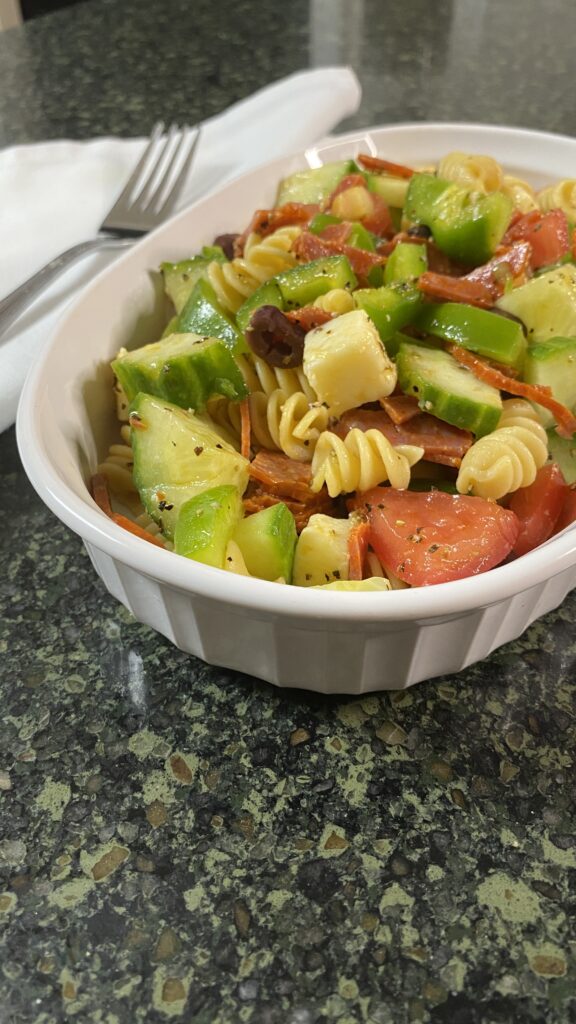
Best Cold Pasta Salad
To make my pasta salad healthful as well as delicious, I use the best ingredients I can get my hands on. Only the freshest veggies for me, and pure virgin olive oil and red wine vinegar without any additives. And for the pasta, I use Barilla Rotini Plus pasta because it’s not just made from normal flour–it’s also made from a legume flour blend that includes lentils, chickpeas, flaxseed, barley, spelt, and oats, so it’s’ got 10 grams of protein and 4 grams of fiber per 2 oz serving. Barilla Plus also tastes better to me, and seems to be easier to cook to just the right texture without it getting too soggy. And I use the rotini shape, also known as corkscrews, because it really does a great job holding the dressing, and because it’s easy to mix bites with just the right mix of pasta and veggies.
What you’ll need for this recipe
{Essentially ingredients but provide short description of each following similar format to this:
- (1) box Barilla Plus Rotini pasta
- (2) large, fresh Roma tomatoes
- (1) fresh green bell pepper
- 1/2 cup packed olives
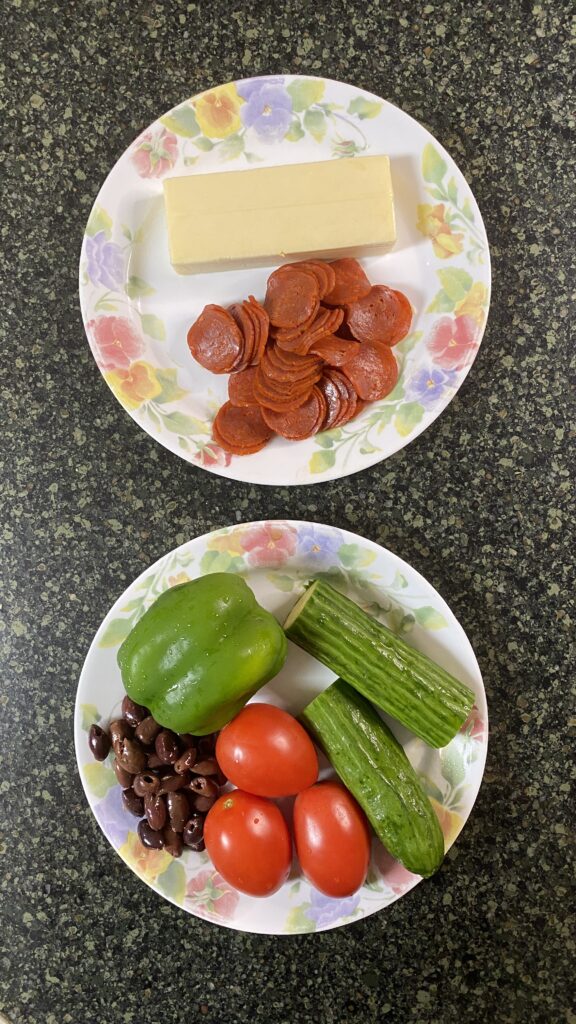
How to make it
This cold pasta salad recipe is super easy to make. (In fact, most of the time it takes is simply in chopping up the veggies, meat, and cheese; the only part of this recipe that requires cooking is the pasta, itself.)
There are, of course, lots of variations on how to make pasta salads–and lots of different variations on ingredients. This particular recipe for cold pasta salad is more of an Italian-style pasta salad, and is even dressed with an oil and vinegar dressing. (Classic Italian subs often include cheeses, meats like pepperoni, and are often dressed with oil and vinegar.)
You can save time on making this recipe by gathering together all your ingredients and kitchen tools together at the beginning.
Preparing the Pasta
Once you have everything gathered that you’ll need, Start your pot of water boiling on the stove. I usually boil the water on high to get it boiling as quickly as possible, then turn it back a little when I add the pasta–enough so that it’s still boiling, but slightly less vigorously so that it less likely to boil over.
(You don’t want to leave your pot of water unattended while it’s heating up, nor do you want to leave your pot alone will the pasta is cooking, but you CAN use this time to clean and chop your other salad ingredients. Doing this, you can cut your total preparation time for this salad down to about 10 minutes!)
In a large pot, bring 8-10 cups of spring or filtered water to a boil; add pasta and cook to al dente, according to package instructions.
As soon as the pasta is done, strain it in a colander in the sink.
Rinse pasta well in cold water, tossing it as you go to make sure all the pasta is rinsed and is given a chance to be cooled by the water.
Drizzle 2 T of oil over pasta, tossing until well coated.
Preparing the Veggies, Meat, and Cheese
Wash veggies thoroughly with water–or with an ultrasonic device, if preferred.
Chop veggies into small (about 1-2 cm) pieces that will easily fit on a fork, and set aside.(If using whole black olives, slice them, press them flat as you slice them to feel for any pit fragments that may remain in the the olive; remove any fragments before using the olives in this recipe.)
Slice pepperoni into thin strips and set aside.
Cut the cheese into 1 cm cubes and set aside.
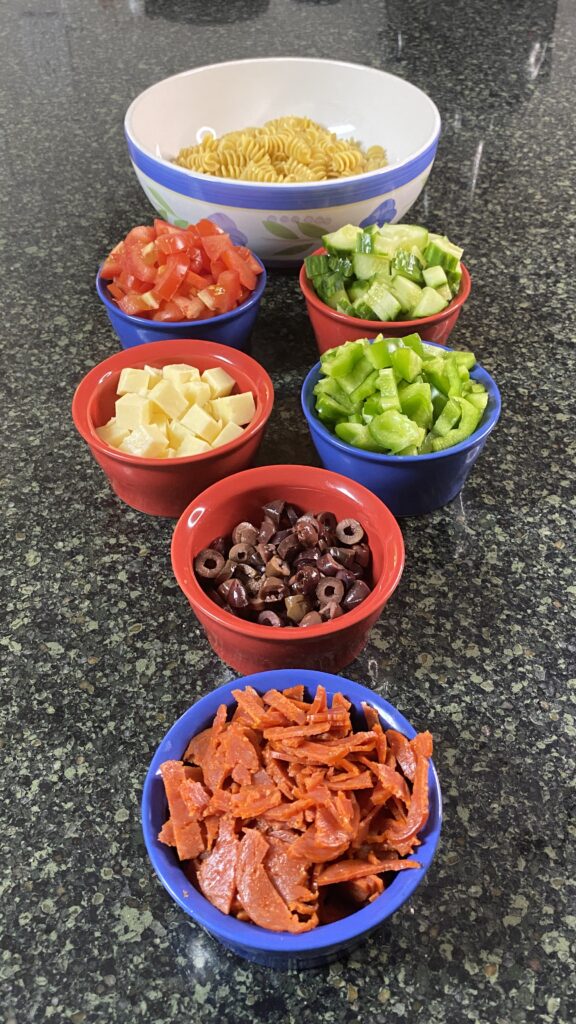
Putting it all Together
Combine 4 cups cooked pasta, 1 cup chopped green peppers, 1 cup chopped tomatoes, 4 ounces cubed cheese, 1/2 cup sliced black olives, 1 cup chopped English cucumber, and 6 ounces chopped pepperoni, in large bowl.
Toss prepared salad with 2 T apple cider vinegar, an additional 2 T olive oil, and pepper, and toss until well coated.
Time to Eat!
Distribute to serving bowls or plates.
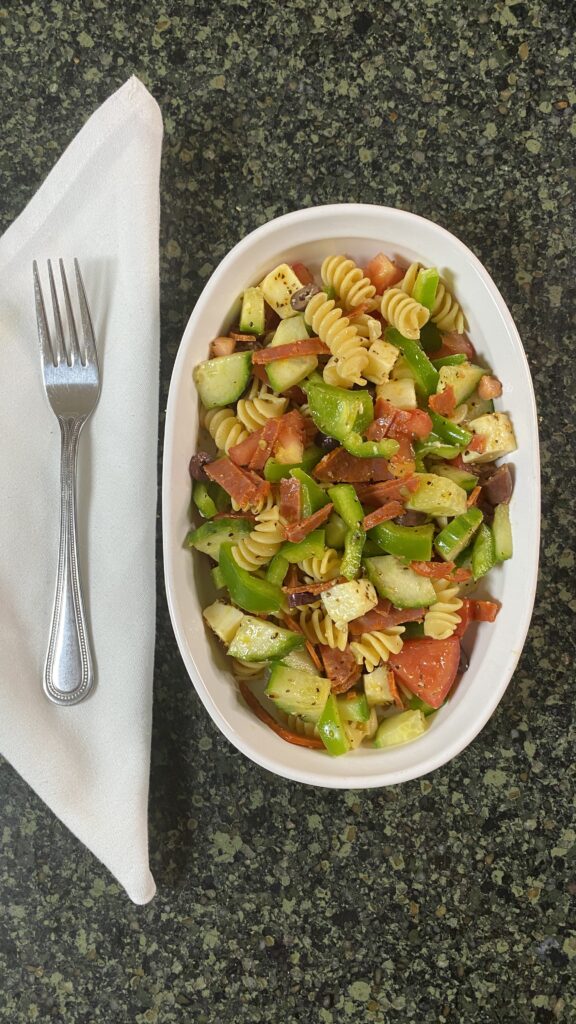
Serving Suggestions
This cold pasta salad is great for parties or large gatherings. It can also makes for a nice, light meal–especially in warmer weather. And of course, Italian pasta salad with pepperoni has long been a popular side dish alongside a hamburger, hotdog, or sandwich as part of an easy and flavorful lunch.
Ways to spice this recipe up!
This cold pasta salad recipe already uses a high-protein pasta. You can further bump the protein for this salad by subbing cubed, cooked chicken breast for the pepperoni.
A low-calorie or creamy-style dressing can be substituted for the oil and vinegar dressing in this recipe, if you prefer. I used olive oil and apple cider vinegar in this recipe for both taste and health reasons.
Tips
- Gather your ingredients and cooking tools and equipment together before you begin.
- Rinse pasta well in COLD WATER after cooking. Warm pasta will soften your cheese and start to raise the temperature of your pepperoni, which may shorten the length of time your pasta salad will stay good. Cheese and pepperoni are best eaten cold, or hot–not somewhere in-between. Rinsing the past well after cooking will also help the pasta to not be sticky.
- Use the freshest ingredients possible for best flavor, color, texture, and maximum nutrition!
- Thoroughly wash veggies before use!
- Boil pasta in spring or filtered water rather than tap water.
- Add olive oil and vinegar dressing right before serving, if possible, or as close as possible before serving, rather than a long time in advance.
- Use pretty serving dishes to show off your beautiful pasta salad.
- Save this recipe for future use, and share with family and friends!
Frequently Asked Questions
What are five mistakes to avoid when making pasta salad?
1) Using Veggies that are Old
Don’t use old veggies!
Because you’re using fresh vegetables in this recipe, you’ll really notice the difference using the freshest vegetables available makes.
2) Using Dirty Vegetables
Don’t use dirty vegetables!
Remember to gently clean all your vegetables before adding them to your pasta salad. This will make sure your vegetables are clean and won’t make you sick. (This is especially important in recipes like pasta salad that use fresh vegetables, where you can’t rely on the heat from the cooking process to make sure your food is safe to eat.)
You can wash vegetables by rinsing them under water. There are also some spray-on, food-safe solutions like Veggie Wash cleaning liquid. You can also scrub it GENTLY with a special tool meant for cleaning fresh vegetables like this all-natural vegetable brush made from coconut fibers or one of these gently fruit scrubbers. The best option, however, may be ultrasonic fruit and vegetable cleaners.
What the best way to wash fruits and veggies when you’re going to eat them raw? According to research quoted on Martha Stewart’s website, new ultrasonic cleaning methods may be many times more effective than other cleaning methods for fruits and vegetables: you can find some of these at-home ultrasonic veggie cleaners online.
3) Using Leftover Pasta Noodles to make Pasta Salad
Avoid using leftover pasta in this Pasta Salad recipe!
Freshly prepared pasta, properly prepared, will have superior texture and flavor for your pasta salad. (If your really want to use leftover pasta for your pasta salad recipe, at least freshen up your pasta first by giving it a short bath in HOT water. (Preferably, boil a pot of fresh spring water, then turn off the heat.)
The time you leave the pasta in the hot water depends on how much moisture the pasta lost while it was hanging out in your refrigerator as a leftover. Once you add the pasta to the water, pull out a piece to test after a minute or so, using a slotted spoon or similar tool. (Ideally, the pasta should be al dente in texture. In other words, firm to the bite, as opposed to overly soft or mushy–and should feel like it’s been freshly prepared.) If the pasta needs a little more time in the hot water bath, test it every thirty seconds or so to make sure you don’t soak it too long.
4) Boiling Pasta in Tap Water
Don’t boil pasta in tap water!
Only use filtered water or spring water.) Pasta boiled in tap water will absorb whatever chemicals (such as chlorine) are in the tap water, itself–and most people don’t like the taste of chlorine. In addition, most people prefer not to inject chlorine, if they can avoid it, for perceived health reasons. Personally, I always filter my tap water using a water pitcher filtration system to remove chlorine taste and smell before cooking with that water when boiling pasta, rice, cooking meat or vegetables, etc.
5) Adding the Dressing in Advance
For the freshest tasting pasta salad, don’t add dressing in advance!
When making pasta salad, it’s best to only apply the dressing to the portions you think will be eaten right away. If you think a portion will be saved for leftovers, it’s usually best to store leftover portions SEPARATELY from the dressing because the dressing will be deeply absorbed by the pasta as it sits, and this leaves less on the surface of the pasta and able to be tasted. Then, you’re just getting extra calories without the flavor.
The dressing for this pasta salad is simple, with only two ingredients–apple cider vinegar and olive oil–so it’s easy to throw the dressing together at the last second before applying. But if you want to prepare the dressing in advance, you can do that, too. Just combine the oil and vinegar in a small, sealed container, and it’s fine to leave out on your counter until you need it. (Since neither oil nor vinegar need to be refrigerated, this dressing doesn’t require refrigeration for food safety.) Lots of dispensers for homemade dressings are available on the market today.
Is pasta salad is best made the day before serving?
In my experience, pasta salad is best made the same day it’s served. This is not a hard and fast rule, but the tomatoes in the salad will taste the best if freshly cut.
If you want to make the pasta salad ahead of time, but you also want to preserve best taste, you can compromise by pre-cutting only the ingredients that won’t degrade in quality when prepped ahead of time. Try preparing the oil and vinegar dressing ad pre-cutting the black olives, pepperoni, cheese, green peppers, and cucumbers up to a day in advance, while preparing the pasta and cutting the tomatoes the day you’ll be serving the pasta salad.
How long is pasta salad good?
The pasta salad will taste best if it’s served and eaten shortly after being prepared. If you have leftovers, keep in mind that the pasta salad will become softer faster if it’s already been combined with the dressing because vinegar speeds up the breakdown of food and softens the fresh vegetables.
In terns of food safety, a good reference is the Food Safety website maintained by the US Government. They maintain a chart for cold food storage that states rule-of-thumb storage times for various foods. The United States Department of Agriculture (USDA) offers a more extensive list of safe food storage times through it’s USDA FoodKeeper app, which you can either download and install on your smartphone, or search online. FoodKeeper app give the following estimates for how long the individual ingredients in this pasta salad recipe will last:
- Fresh, whole tomatoes: 7 days after fully ripe
- Fresh, whole cucumbers: 4-6 days when refrigerated
- Fresh, whole green peppers: 4-14 days when refrigerated
- Black olives: 2 weeks, when refrigerated after opening
- Cheese (hard, such as cheddar or swiss): 3-4 weeks when refrigerated after opening
- Pepperoni (hard, dry): 2-3 weeks when refrigerated after date of purchase
How long can you leave pasta salad out?
According to the USDA, food left out at room temperature should be discarded if it sits for more than two hours.
If left out in the heat of summer, like might happen at a barbecue or picnic, rather than inside in the air conditioning, it may go bad faster. To help it last longer, consider serving the pasta salad from a
Why does my pasta salad get dry?
Pasta salad can get dry if the pasta was not cooked long enough to allow it to absorb enough water, or if the pasta is cooked, then left open to the air long enough that the water in the noodles starts evaporating into the air. If your pasta salad starts getting dry when it’s stored in the refrigerator, it’s either due to the noodles losing moisture as it slowly evaporates out, or because the pasta has absorbed too much of the dressing, rather than the dressing coating the outer later of the pasta.
If you’ve stored your pasta separate form the veggies, you can re-hydrate the noodles by giving them a hot water bath as I described in the section “What are five mistakes to avoid when making pasta salad?” mistake #3. If your pasta salad is already assembled and all ingredients are mixed together, you can try to undo some of the “dryness” by adding a bit more oil and vinegar dressing.
How do you keep pasta salad from sticking?
- Make sure you are cooking your pasta only to al dente (firm) texture; do not overcook, as this can make the pasta soft and sticky!
- Always rinse your pasta thoroughly with cold water in a colander after boiling.
- Don’t skip tossing the pasta with 1-2 Tablespoons of olive oil immediately after the cold water rinse. Noodles that are lightly coated in olive oil are unlikely to stick!
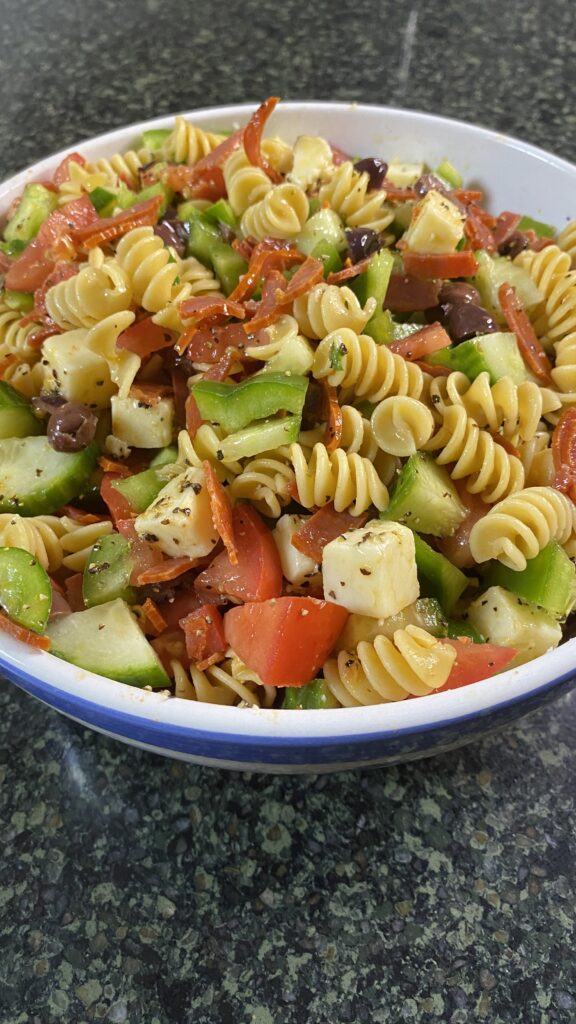
If you love this recipe, try these next time!
This best cold pasta salad is easy to make, festive, and a tasty way to get more fresh veggies into your diet.
Enjoy!
How to make the Best Cold Pasta Salad
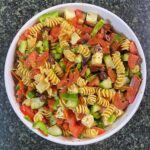
This cold pasta salad recipe is great for a light summertime meal, snack, or side dish. It's also great to bring to parties and your warm-weather gatherings. With lots of raw veggies, plus protein-rich pasta, pepperoni, and white cheddar cheese, this pasta salad is both healthy and satisfying. It's finished with a simple olive oil and apple cider vinegar dressing–so that's healthy, too!
- large pot
- kitchen knife
- measuring spoons
- measuring cup
- cutting board or plate
- serving bowls or plates
- tongs
- 1/2 fresh green bell pepper (chopped)
- 1/2 cup black olives (sliced)
- 2 whole large plum tomatoes (chopped)
- 1/2 whole English cucumber (chopped)
- 6 oz Hormel Turkey Pepperoni (70 percent less fat than traditional pepperoni)
- 5 ounces white cheddar cheese (cut into 1 cm cubes)
- 2 tsp ground pepper
- 1/3 cup apple cider vinegar
- 4 tbsp olive oil (cold pressed)
- 4 cups Barilla Plus rotini pasta (cooked)
In a large pot, bring 8-10 cups of spring or filtered water to a boil; add pasta and cook to al dente, according to package instructions.
As soon as the pasta is done, strain it in a colander in the sink.
Rinse pasta well in cold water, tossing it as you go to make sure all the pasta is rinsed and is given a chance to be cooled by the water.
Drizzle 2 T of oil over pasta, tossing until well coated.
Wash veggies thoroughly with water–or with an ultrasonic device, if preferred.
Chop veggies into small (about 1-2 cm) pieces that will easily fit on a fork; set aside.
(If using whole black olives, slice them, press them flat as you slice them to feel for any pit fragments that may remain in the the olive; remove any fragments before using the olives in this recipe.)
Slice pepperoni and cube cheese.
Combine 4 cups cooked pasta, 1 cup chopped green peppers, 1 cup chopped tomatoes, 4 ounces cubed cheese, 1/2 cup sliced black olives, 1 cup chopped English cucumber, and 6 ounces chopped pepperoni, in large bowl.
Toss prepared salad with 2 T apple cider vinegar, an additional 2 T olive oil, and pepper, and toss until well coated.
Distribute to serving bowls or plates.
Did you enjoy this post?
Then consider following me on Pinterest, and Youtube! And don’t forget to subscribe to my email list so you stay up to date with my most recent content! 🙂
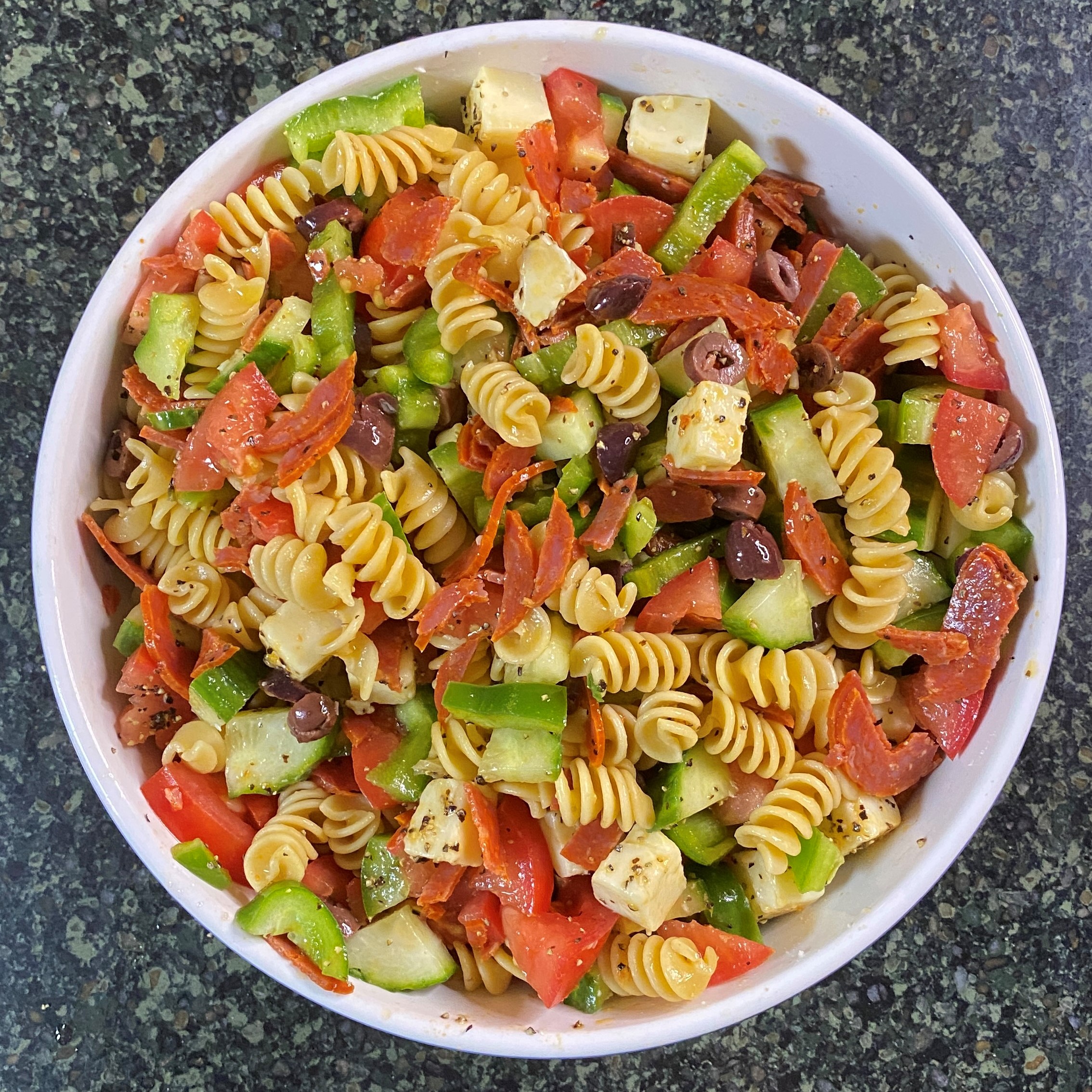
Trackbacks/Pingbacks